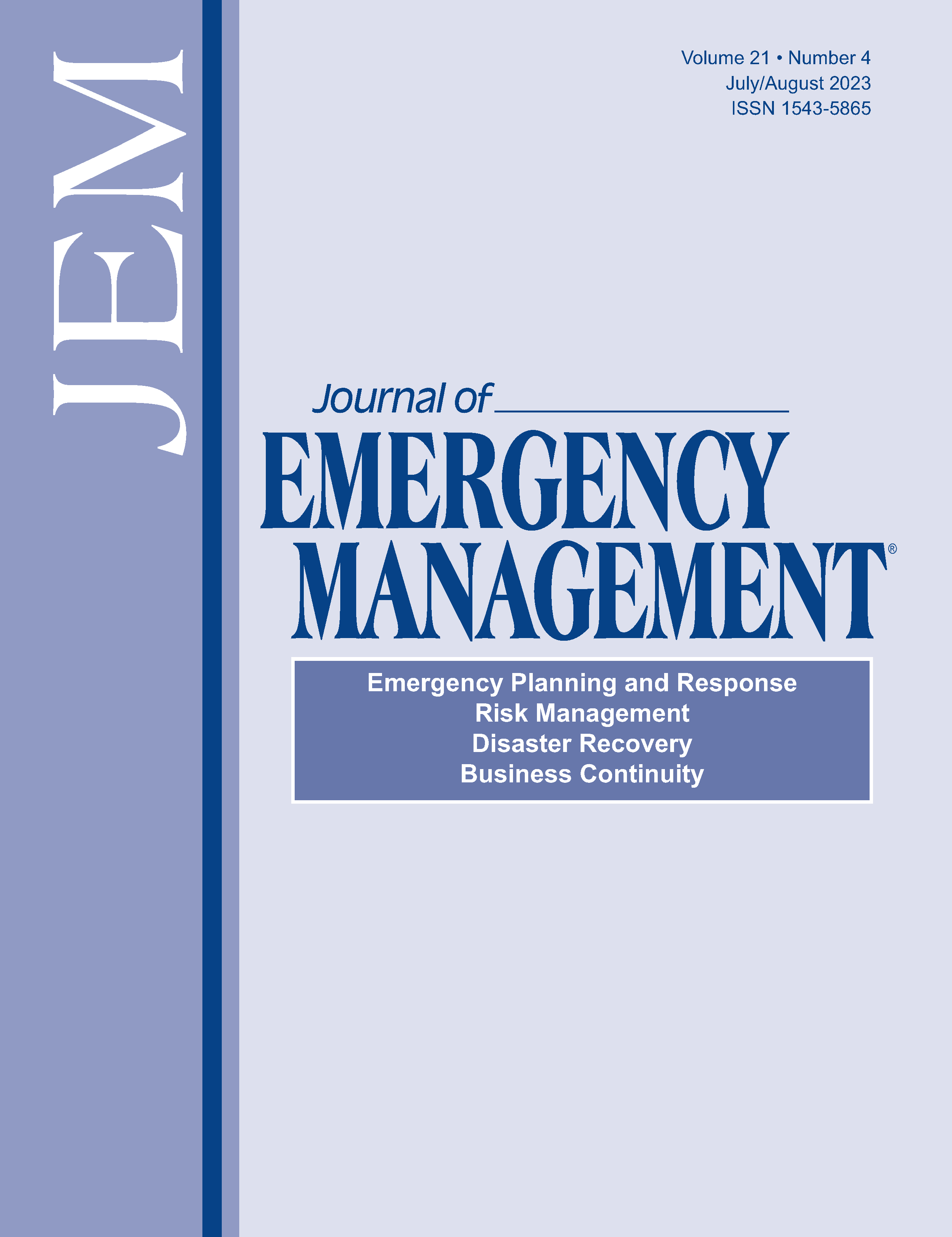Conclusions from a needs analysis: The PIO training gap in the National Preparedness Goal
DOI:
https://doi.org/10.5055/jem.0794Keywords:
National Preparedness Goal, public information officer, course learning objectives, federal emergency management administration, trainingAbstract
At the national level, the field of emergency management has distinctive capabilities and responsibilities organized by the United States Department of Homeland Security and Federal Emergency Management Agency (FEMA) doctrine. Key to this doctrine is the goal: a secure and resilient nation. This goal is known as the National Preparedness Goal (NPG). The NPG is supported by five missions, and these five missions are supported by 32 core capabilities. One of the core capabilities is Public Information and Warning. This core capability is so important and spans all five missions.
“. . . Public information is a vital function in disaster operations that contributes greatly to saving lives and protecting property.” Public information officers (PIOs) are responsible for collecting, analyzing, verifying, and communicating risk, crisis, and recovery information to a wide variety of people across the “whole community.”
This needs analysis conducted as a component of this paper demonstrated a need for a strategic, coordinated, and unified approach to training PIOs in the NPG. A review of employee training literature, along with the conclusions from the needs analysis and the central role the NPG plays in FEMA doctrine, revealed the value of integrating the NPG into PIO training.
The purpose of this paper was to determine to what extent the NPG identifies training procedures to empower PIOs to fulfill their communication responsibilities within the NPG and to determine if current PIO training is preparing PIOs to support their NPG responsibilities.
Content analysis methodology was used to determine to what extent training was described within the NPG. Cross-tabulation (Crosstab) methodology was utilized to determine coincidence between existing PIO training course learning objectives (CLOs) and the NPG.
This paper may serve as a framework for aligning PIO training with the NPG. Furthermore, once completed, this paper may serve as tool to evaluate PIO training, communication planning, and post-incident after-action reports.
Content analysis of the NPG revealed no description of training recommendations or training regimen for PIOs and/or emergency managers to fulfill their NPG responsibilities. Crosstab methodological data analysis revealed a 53 percent coincidence between the NPG and the PIO CLOs.
The NPG is FEMA’s standard for national emergency preparedness. Communication, and thus PIOs, plays a significant part in fulfilling this standard. The more PIOs can be trained in achieving the NPG communication mission, the more resilient the whole community will be when there are crises.
References
Department of Homeland Security (DHS): Federal Emergency Management Agency: National Preparedness Goal. 2nd ed. Department of Homeland Security, 2015. Available at https://www.fema.gov/sites/default/files/2020-06/national_preparedness_goal_2nd_edition.pdf. Accessed December 8, 2021.
Kozlowski S, Brown K, Weissbein D, et al.: A multilevel approach to training effectiveness. In Klein K, Kozlowski S (eds.): Multi-Level Theory, Research, and Methods in Organizations. San Francisco, CA: Jossey-Bass, 2000: 157-210.
Biech E: 10 Steps to Successful Training. Alexandria, VA: American Society for Training & Development (Now Known as the Association for Talent Development), 2009.
Aragon IB, Valle RS: Does training managers pay off? Int J Hum Resour Manag. 2013; 24(8): 1671-1684.
Tharenou P, Sakes AM, Moore C: A review and critique of research on training and organizational-level outcomes. Hum Resour Manag Rev. 2007; 17(3): 251-273.
Federal Emergency Management Agency: Emergency Management Institute: Public information officer. 2021. Available at https://training.fema.gov/programs/pio/. Accessed December 8, 2021.
Federal Emergency Management Agency: Federal emergency management agency: National Incident Management System. 2022. Available at https://www.fema.gov/emergency-managers/nims. Accessed December 8, 2021.
Federal Emergency Management Agency: The national response framework. 2019. Available at https://www.fema.gov/sites/default/files/2020-04/NRF_FINALApproved_2011028.pdf. Accessed December 8, 2021.
Federal Emergency Management Agency: Emergency Management Institute: ICS review document. 2018. Available at https://training.fema.gov/emiweb/is/icsresource/assets/ics%20review%20document.pdf. Accessed February 2, 2022.
Department of Homeland Security: National response plan. n.d. Available at https://www.dhs.gov/xlibrary/assets/NRP_Brochure.pdf. Accessed February 2, 2022.
Federal Emergency Management Agency: Emergency Management Institute: E/L 0388 advanced public information officer. 2022. Available at https://training.fema.gov/programs/pio/e388.aspx. Accessed December 9, 2021.
Federal Emergency Management Agency: National emergency management basic academy: Public information basics. E0105 visuals unit 1—slides 9 through 11. 2020. Available at https://training.fema.gov/empp/e105.aspx. Accessed December 10, 2021.
Kleinheksel AJ, Rockich-Winston N, Tawfik H, et al.: Demystifying content analysis. AJPE. 2020; 84(1): 7113. DOI: 10.5688/ajpe7113.
Qualtrics: Cross-tabulation analysis: A researchers guide. 2022. Available at https://www.qualtrics.com/experience-management/research/cross-tabulation. Accessed March 21, 2022.
Nonaka I: A dynamic theory of organizational knowledge creation. Organiz Sci. 1994; 5(1): 14-37. Available at http://www.jstor.org/stable/2635068. Accessed March 21, 2022.
Department of Homeland Security (DHS): Federal emergency management agency: A whole community approach to emergency management: Principles, themes, and pathways for action. 2011. Available at https://www.fema.gov/sites/default/files/202007/whole_community_dec2011__2.pdf. Accessed December 9, 2021.
Published
How to Cite
Issue
Section
License
Copyright 2007-2025, Weston Medical Publishing, LLC and Journal of Emergency Management. All Rights Reserved.






